Federal Forces of Nouvelle Alexandrie
| Federal Forces of Nouvelle Alexandrie | |
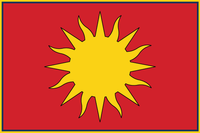 The Federal War Banner (1673 AN) | |
| Country |
|
|---|---|
| Founded | 1685 AN |
| Branches |
Grand Army of the Federation, Federal Navy, Federal Air Force, Federal Space Force, Federal Guards Service |
| Headquarters | El Fuerte, Cárdenas |
| Leadership | |
| King | Sinchi Roca I |
| Secretary of Defense | Maximilian de Almagro |
| Chairman of the Joint Chiefs of Staff | Borzou Gankhaki |
| Manpower | |
| Military age | 18–65 years old |
| Active personnel |
|
| Reserve personnel |
|
| Expenditures | |
| Domestic suppliers | Ahvaz Automotive Engineering Company, ESB Susa, Javelin Industries, National Qullqa System, Pontecorvo Firm |
| Foreign suppliers | |
The Federal Forces of Nouvelle Alexandrie (FFNA) are the military forces of the Federation of Nouvelle Alexandrie. Originally constituted as the Alduro-Wechua Armed Forces upon the founding of the Federation of Alduria and the Wechua Nation in 1685 AN. The armed forces are tasked by the Proclamation of Punta Santiago to guarantee the sovereignty and independence of Nouvelle Alexandrie, defend its territorial integrity, and the constitutional order.
The Federal Forces of Nouvelle Alexandrie consist of five service branches: the Grand Army of the Federation, the Federal Navy, the Federal Air Force, the Federal Space Force, and the Federal Guards Service.
From its inception in 1685 AN as the union of the Aldurian and Wechua armed forces, the FFNA have played key roles in the history of Nouvelle Alexandrie. The armed forces have helped create a sense of national unity and identity at many points in New Alexandrian history, especially during the early years where the Federation expanded rapidly in territory. The Defense of the Federation Act, 1694 and the Home Guard Act, 1711 are crucial pieces of law that established the Federal Military Establishment, headed by the Secretary of Defense.
The King of Nouvelle Alexandrie heads the armed forces as its commander-in-chief. The Council of State forms military policy and the Secretary of Defense acts as the principal person to carry those policies out. The FFNA draws its personnel from a large pool of professional volunteers. Though the Proclamation of Punta Santiago allows military conscription, it has not been used. The government of Nouvelle Alexandrie retains the power to conscript males and females, requiring all citizens and residents between the ages of 18 and 30 to register in the conscription rolls.
History
Formed from the Military of Alduria and the Military of the Wechua Nation in 1685 AN. Transfer of allegiance to the Federation of Nouvelle Alexandrie took place during 1693 AN.
Current missions
Contributions to Raspur Pact theatre commands
| Continental Theatre Command | Material allocation (%) | Lead Nation |
|---|---|---|
| Home Service (Federal Districts) | 5% | |
| Apollonia Command | 30% | |
| Keltia Command | 35% | |
| Trans-Euran Command | 30% |
Ongoing operational deployments
Concluded operational deployments
Command Structure
The interim command structure, implemented 24.VII.1690, directly replicates that introduced by the Sanaman Armed Forces, allowing for differences in local circumstances and organisation.
Joint Chiefs of Staff Council
The Joint Chiefs of Staff Council is the body of the most senior commanders of the Alduro-Wechua Armed Forces, providing advice to the King of Alduria-Wechua, the Secretary for Defence, and other entities on military matters. The council does not have operational command over the armed forces. Operational command flows from the King as Commander-in-Chief, through the Secretary for Defence, to the Joint Commanders in the field. The council consists of the Chairman of the Joint Chiefs of Staff Council, the Vice Chairman, the Commanding General of the Federal Army, the Chief of the Admiralty, the Chief of Staff of the Federal Air Force, the Commandant of the Federal Coast Guard, and the Commandant-General of the Federal Guards Service.
| Office | Holder | Tenure |
|---|---|---|
| Chairman of the Joint Chiefs of Staff Council | Marshal General Borzou Gankhaki |
|
| Vice-Chairman of the Joint Chiefs of Staff Council | General Manuel Antonio Foch |
|
| Commanding General of the Federal Army | Captain General of the Army Balthazar Fernandez |
|
| Chief of the Admiralty | Captain General of the Federal Navy Claude Delacroix |
|
| Chief of Staff of the Federal Air Force | Captain General of the Federal Air Force Joachim Beaumarchais |
|
| Commandant-General of the Federal Guards Service | Captain General of the Federal Guards Service Nadir Maher |
|
General Staff
The General Staff is the organisation supporting the Joint Chiefs of Staff Council in the performance of its duties. The General Staff handles both preparation for royal and security council briefings, research and development, as well as operational control of several units staffed by the different armed services.
- Office of the Chairman of the Joint Chiefs of Staff Council
- Office of the Vice-Chairman of the Joint Chiefs of Staff Council
- Manpower and Personnel Directorate (D1)
- General Service Directorate (D2)
- Operations and Planning Directorate (D3)
- Logistics Directorate (D4)
- Communications Directorate (D5)
- Armed Forces Development Directorate (D6)
- Force Structure, Resources and Evaluation Directorate (D7)
Branches
Army
The Grand Army of the Federation comprises of thirty Territorial Defence Units, corresponding to the equivalent number of states within the federation for which they have defensive responsibility, supported by twenty-three airmobile Rapid Response Units. These units are then organised into six Combined Arms Corps, each corresponding to five of the regions of the federation and a sixth (Outremer) concerned with overseas and colonial deployments, bolstered with air-defence, armour, and artillery regiments.
As noted, the VI (Outremer) Combined Arms Corps encompasses the ten new states and eleven special cities mooted in the colonial expansion of 1688. Owing to the geographically dispersed nature of these new colonies, this combined arms corps is orientated towards cooperation with naval forces and the marines as well as the organisation of local levies and volunteer forces drawn from settler communities.
The personnel of the army are organised into regimental corps based on their combat role. Each regimental corps is headed by a staff responsible for training and doctrine within the corps. The regimental corps staff do not command the field regiments affiliated to the corps. The staff and training units are organised into regiments. The regimental corps inspector-general reports directly to the Army Staff.
- Regimental Corps of Infantry
- Regimental Corps of Artillery
- Regimental Tank Corps
- Regimental Air Defence Corps
- Regimental Corps of Engineers
- Regimental Signals Corps
- Regimental Corps of Aviation
- Regimental Intelligence Corps
- Regimental Corps of Transport and Logistics
- Adjutant General's Corps
- Regimental Corps of Medical Services
With the proposed expansion of the Alduro-Wechuan occupation of Lyrica receiving the green light from the international community, a seventh combined arms corps headquarters was established in mid-1689 AN with the deduction of a squadron from each field infantry regiment hitherto assigned to territorial defence units within the other CACs. These would form the basis of regimental combat teams sent out to secure the locations identified for colonial settlement, with shortfalls in infantry numbers being made good by transfers from combat support services, the navy, the air force, and the federal border guard.
Home Service
| Unit | Subordinate Units | Headquarters | Garrisoned Area |
|---|---|---|---|
| II (Federal Capital District) CAC | |||
| 2nd C&CU |
|
Cardenas | Federal Capital District |
| 2nd ACU |
|
Cardenas | Federal Capital District |
| 2nd ADU |
|
Cardenas | Federal Capital District |
| 552nd RRU |
|
Cardenas | |
| III (Wechua Nation) CAC | |||
| 3rd C&CU |
|
Parap | Wechua Nation |
| 3rd ACU |
|
Parap | Wechua Nation |
| 3rd ADU |
|
Parap | Wechua Nation |
| 545th RRU |
|
Cochabamba | |
| 546th RRU |
|
Rimarima | |
| 548th RRU |
|
Huancavelica | |
| 549th RRU |
|
San Luis | |
| 550th RRU |
|
Kedah | |
| 551st RRU |
|
Roanne | |
| 19th TDU |
|
Cajamarca | Antisuyu |
| 20th TDU |
|
Midyan | Chinchasuyu |
| 21st TDU |
|
Huichajanca | Kuntisuyu |
| 22nd TDU |
|
Rimarima | Qullasuyu |
| 23rd TDU |
|
Potosi | Santander |
| IV (Santander) CAC | |||
| 4th C&CU |
|
Potosi | Santander |
| 4th ACU |
|
Potosi | Santander |
| 4th ADU |
|
Potosi | Santander |
| 553rd RRU |
|
Ciudad Real | |
| 554th RRU |
|
Wechuahuasi | |
| 555th RRU |
|
Port of Jirishanca | |
| V (Valencia) CAC | |||
| 5th C&CU |
|
New Franciscania | Valencia |
| 5th ACU |
|
New Franciscania | Valencia |
| 5th ADU |
|
New Franciscania | Valencia |
| 556th RRU |
|
Chambery | |
| 557th RRU |
|
Mayenne | |
| 558th RRU |
|
New Franciscania | |
| 559th RRU |
|
Port Cardozo | |
| VI (Outremer) CAC | |||
| 6th C&CU |
|
Pharos City |
|
| 6th ACU |
|
Ciudad de Howard |
|
| 6th ADU |
|
Ciudad de Howard |
|
| 1st CDU | Port Tablot Volunteer Rifle Regiment | Port Tablot | |
| Gotfriedplatz Volunteer Rifle Regiment | Gotfriedplatz | ||
| Velez Volunteer Regiment of Yeomanry | Velez | ||
| Port Karsten Harbour Defence Force | Port Karsten | ||
| 2nd CDU |
|
Pharos City | |
| 3rd CDU | Benavides | ||
| LeClerc | |||
| Intillaqta | |||
| 4th CDU | Nuevo Corcovado | ||
| Ciudad de Howard | |||
| Jaris Garrison |
|
Ijubicastagrad Harbor | |
| Regimental Corps | |||
| Regimental Corps of Infantry | All infantry regiments | ||
| Regimental Corps of Artillery | All artillery regiments | ||
| Regimental Tank Corps | All armoured regiments | ||
| Regimental Air Defence Corps | All area defence regiments | ||
| Regimental Corps of Engineers | All engineer or pioneer regiments | ||
| Regimental Signals Corps | All signals regiments or detachments | ||
| Regimental Corps of Aviation | All airlanding or parachute regiments | ||
| Regimental Intelligence Corps | All reconnaissance and special forces regiments | ||
| Commissariat Corps | All general support and works & maintenance Regiments | ||
| General Inspectorate | All security regiments | ||
| Regimental Corps of Medical Services | |||
| Other units | |||
| Army Headquarters Command | All command & control Regiments | ||
| Land Combat School | |||
| Army Technical School | |||
| Jungle Warfare School | |||
| Staff College | |||
| Royal Military Academy | |||
210th Army (Lyrica)
| Unit | Subordinate Units | Headquarters | Garrisoned Area |
|---|---|---|---|
| VII (Lyrica) CAC | |||
| 7th C&CU |
|
Southern District | |
| 547th RRU |
|
Southern District | |
| 25th LEU (Alexandrian Legion) |
|
Southern District | |
| 27th LEU (Alexandrian Legion) |
|
Southern District | |
| 28th LEU (Alexandrian Legion) |
|
Southern District | |
| 5th CDU |
|
Southern District | |
| OMGS |
|
Southern District | |
| IX (Lyrica) CAC | |||
| 1st LEU (Alexandrian Legion) |
|
Cantonments VIII | North Lyrica |
| 2nd LEU (Alexandrian Legion) |
|
Beaufort | North Lyrica |
| 12th LEU (Alexandrian Legion) |
|
Cantonment VII | North Lyrica |
| 24th LEU (Alexandrian Legion) |
|
Cantonment VI | North Lyrica |
| 26th LEU (Alexandrian Legion) |
|
La Fortaleza de Mehusina | North Lyrica |
| 29th LEU (Alexandrian Legion) |
|
Montchiery | North Lyrica |
| OMGN |
|
Beaufort | North Lyrica |
211th Army (Lyrica)
| Unit | Subordinate Units | Headquarters | Garrisoned Area |
|---|---|---|---|
| VIII Corps | |||
| VIII Corps Headquarters |
|
Buenaventura | South Lyrica |
| VIII / 1st Division |
| ||
| VIII / 2nd Division |
| ||
| VIII / 3rd Division |
|
La Hermandad | South Lyrica |
| VIII / 4th Division |
| ||
| IX Corps | |||
| IX Corps Headquarters |
|
Humahuaca | South Lyrica |
| IX / 1st Division |
|
Sonoma | |
| IX / 2nd Division |
|
Humahuaca | |
| IX / 3rd Division |
|
Nouveau Geneva | |
| IX / 4th Division |
|
Ciudad Roas | |
513th Army (Alduria)
| Unit | Subordinate Units | Headquarters | Garrisoned Area |
|---|---|---|---|
| I Combined Arms Corps | |||
| 1st C&CU |
|
Punta Santiago | Alduria |
| 1st ACU |
|
Punta Santiago | Alduria |
| 1st ADU |
|
Punta Santiago | Alduria |
| 19th RRU |
|
Punta Santiago | |
| 31st RRU |
|
Piriya | |
| 36th RRU |
|
Beauharnais | |
| 45th RRU |
|
Amapola | |
| 78th RRU |
|
Fort Laons | |
| 541st RRU |
|
Rothborne | |
| 542nd RRU |
|
Norvind | |
| 543rd RRU |
|
Alkhiva | |
| 544th RRU |
|
Susa | |
| XV Territorial Defence Corps | |||
| 1st TDU |
|
Alcalá | |
| 2nd TDU |
|
Aldurian Capital District | |
| 3rd TDU |
|
Alduria City | Altus |
| 4th TDU |
|
Asuara | |
| 5th TDU |
|
Biscarrosse | |
| 6th TDU |
|
Carrillo | |
| 7th TDU |
|
Compostela | |
| 8th TDU |
|
Mondego | |
| 9th TDU |
|
Murcia | |
| 10th TDU |
|
Napoléon | |
| XVI Territorial Defence Corps | |||
| 11th TDU |
|
Nouradin | |
| 13th TDU |
|
Saint Ignace | |
| 14th TDU |
|
Rothborne | |
| 15th TDU |
|
Valoria | |
| 16th TDU |
|
Valladares | |
| 17th TDU |
|
Baatharzi Autonomous State | |
| 18th TDU |
|
Ladino Autonomous State | |
| 30th TDU |
|
Valenciana | |
300th Air-Land Combined-Arms Army (Moorland / Normark)
Established as the Alexandrian Expeditionary Force for the Normark campaign (1717–1721). Retained as a strategic reserve force attached to the Northern Banner Group of Keltia Command. The 822nd Reconnaissance Regiment in particular would acquire a sterling reputation for providing cadres of forward air controllers to support local forces during the Wars of the Disinherited.
| Unit | Subordinate Units | Headquarters | Garrisoned Area |
|---|---|---|---|
| X Corps (Rapid Reaction Force) | |||
| Task Force "Vanguard" |
|
Citadele Alexandrin | Normark |
| Task Force "Vigilance" |
|
Nouvelle Alexandrie-Moorland Joint Training Facility | Moorland |
| 1st Armoured Division | |||
| 1st Armoured Division Headquarters |
|
Citadele Alexandrin | Normark |
| 1st / 4th Armoured Brigade |
|
Citadele Alexandrin | Normark |
| 1st / 7th Armoured Brigade |
|
Citadele Alexandrin | Normark |
301st Combined-Arms Army (Boriquén)
| Unit | Subordinate Units | Headquarters | Garrisoned Area |
|---|---|---|---|
| XI Combined Arms Corps (North) | |||
| XIII Combined Arms Corps (South) | |||
302nd Combined-Arms Army (New Caputia)
| Unit | Subordinate Units | Headquarters | Garrisoned Area |
|---|---|---|---|
| XII Combined Arms Corps (East) | |||
| XIV Combined Arms Corps (West) | |||
The Federal Navy of Nouvelle Alexandrie operates a network of naval installations that serve as the backbone for the navy's operational and logistical needs. These installations include home bases, training centers, repair and construction facilities, and command centers, ensuring the Federal Navy's readiness and capability. Reflecting the diverse cultural heritage of Nouvelle Alexandrie, the Navy draws upon the maritime traditions of Alexandria, Caputia, Gotzborg, as well as the indigenous cultures of the Regions within its federation.
The core of the Navy's organizational structure is its fleet dockyards, which are essential for the maintenance, overhaul, and repair of naval vessels. These dockyards also house headquarters units, fueling stations, arsenals, and supply depots. Positioned in strategically defensible locations, they are protected by coastal artillery, harbor defense vessels, and perimeter defense forces. These dockyards are officially designated as "Nouvelle Alexandrie Navy Dockyard" (NAND Dockyard), with abbreviations used as appropriate (e.g., NAND Dockyard Punta Santiago). Ships of the Federal Navy are known as "His Majesty's Ship", or HMS.
Naval Bases are the next tier in the infrastructure hierarchy, offering similar facilities to dockyards but on a smaller scale. Their defense capabilities are also scaled down compared to dockyards. Repair and outfitting facilities at bases are designed to accommodate vessels up to 500 tonnes. These bases are named in a similar fashion to dockyards (e.g., NAND Naval Base San Francisco).
Naval Stations, which are smaller and offer basic repair capabilities and limited defense, support specific missions or temporary operations. These stations provide essential refueling and resupply services for ships, including ammunition, food, and other necessities, though they are not equipped to support major fleet operations. All naval stations include refueling capabilities.
Naval Establishments, the smallest installations, can be located inland or along the coast. They serve as recruitment and training centers for naval personnel, centers for Naval Reserve activities, and support units for naval personnel in combined arms formations.
The manpower of the Federal Navy includes 106 admirals, 515 post-captains, 394 commanders, 2,091 lieutenants, 8,200 other officers, 168,000 enlisted personnel, and 144,000 marines. This reflects the modern, integrated structure of Nouvelle Alexandrie's military forces.
Attempts by the Federal Navy to gain control of the aviation assets deployed aboard its vessels have been continually thwarted by stalwart opposition of the Federal Air Force, a factor that has ultimately contributed to the failure of the Federal Navy to develop a carrier arm to the fleet. Indeed, in some circles of the admiralty it is felt as a keen humiliation that Floria was able to put four fleet carriers to sea before 1723 AN whilst the the Federal Navy has to its name a single light carrier, which, in their eyes, was only suitable for helicopter-borne anti-submarine warfare operations. However, Nouvelle Alexandrie's Navy has made strides in establishing a capable fleet, including the commissioning of state-of-the-art aircraft carriers in 1728 AN, overcoming previous limitations.
Apollonian Fleet
The Apollonian Fleet, responsible for regions such as North Lyrica, South Lyrica, New Luthoria, and Islas de la Libertad, is based at NAND Dockyard Beaufort, with additional bases at Rochefort and Estefanía. It comprises three Battle Groups (Lyrica, New Luthoria, Libertad) and a specialized Submarine Group, highlighting its strategic focus on these key areas.
Euran Fleet
The Euran Fleet, serving Alduria, operates from NAND Dockyard Punta Santiago, with bases at Beauhamais, Alduria City, and Piriya. It includes three Battle Groups (North, West, East), each equipped with cruisers and destroyers, and features two Submarine Groups. The North BG also boasts an Amphibious Assault Ship and a Transport Dock, underscoring its amphibious capabilities.
Keltian Fleet
As the largest component, the Keltian Fleet covers Wechua, Santander, Boriquén, New Caputia, and Valencia. Headquartered at NAND Dockyard Jirishanca, with bases at San Francisco, Mayenne, Corcovado, and San Juan, it is organized into two Battle Groups (West, South) and a robust Submarine Group. This fleet is pivotal for regional security and includes the current flagship light aircraft carrier, HMS Proclamacion, enhancing Nouvelle Alexandrie's naval power projection.
Colonial Marines and Auxiliaries
The remit of the Colonial Marines and the Auxiliaries as a combined force, covered the defence and security of the littoral waters, harbours and port installations, coastal settlements, and overall exclusive economic zone (EEZ) that passed under the sovereignty of Alduria-Wechua during the colonial expansions that followed in the wake of the Proclamation of Punta Santiago. With the majority of existing naval assets assigned to the Apollonian, Euran and Keltian Fleets, in line with their origins with the naval services of Alduria and the Wechua Nation prior to the establishment of the union, the needs of the initial Colonial Fleet were met by a combination of new builds, procured directly from the shipyards of the Pontecorvo Firm, and requisitioned commercial shipping.
Each colonial state of the new foundations (North Lyrica, South Lyrica, etc) serves as the duty station for a Marine Infantry Brigade subordinated to the Colonial Marine Command. A Marine Infantry Brigade consists of four demi-regiments (x1 Command & Control, x2 Landing Force, x1 Raiding Force) and one combat support regiment (x1 Amphibious Mobility Cohort, x1 Artillery Landing Cohort, x1 Combat Service Support Cohort) amounting to a total establishment of 3,600 marines per brigade.
Air Force
The Federal Air Force of Alduria-Wechua had been in existence for a scant five years as of 1690 AN. However in terms of personnel and equipment the air force could trace its lineages back to the aviation arms of the military of Alduria and the military of the Wechua Nation. Both these forces were of minimal establishments, with the burden of air defence both on Eura and Keltia being shouldered by the continental theatre commands of the Raspur Pact. Since the Proclamation of Punta Santiago in 1685, and especially with the ensuing concerted effort to infill the gap between the two realms through an intensive programme of colonisation culminating in the pacification of Lyrica, the air force has had to expand exponentially in order to ensure territorial coverage and support for land and maritime assets that were, at times, perilously spread thin during the campaigns of conquest and settlement that had been embarked upon.
Aware that it would not be facing organised resistance by first rate opponents under any circumstances where the assistance of the Raspur Pact could not be swiftly called upon, the expansion of the air force was initially predicated upon the mass production of comparatively cheap light attack aircraft and medium transport planes - the T-4/A-4 Flecha and the C-11 Mula respectively - distributed across ten air fleets with modern multi-role strike aircraft organised into two Federal Air Defence Wings (one stationed in Cárdenas and the other at Punta Santiago) with the Federal School of Aviation based at Parap receiving the two-seater training versions of the FA-9B Banshee and the remainder of the dedicated training aircraft (x10 T-2/A-2 Saeqeh, x25 T-3 Akóntio, x26 TP-5 Alpha).
The advantage of this programme, although it delayed the building up of an advanced striking force, such as that put into being by Sanama over a comparable period, was that the air force instead focused on building up cadres of experienced pilots, well versed in ground attack missions, ready for conversion to fast jets when these began to enter service as the multinational Project 1700 entered into its maturation and production phase. The modernisation and expansion plans for the air force, centred around the F-9 Ashavan II, F-17 Axarana, Javelin F-18 Cyclone, Javelin Industries helicopter series, and R-2 Krähenwürger heavy assault rotorcraft, are intended to be complete by the year 1720 AN.
Within the aforementioned resource constraints the Federal Air Force attempts to maintain one air fleet per region, subdivided into banner air groups corresponding to the number of states within their respective region of operation. The number of airframes, and accordingly of operational squadrons, is determined by the contributions to the Continental Theatre Commands of the Raspur Pact, as mandated by the Joint Chiefs of Staff. There is a high degree of flexibility in the internal organisation of the air fleets, with the rapid transfer of aircraft and aircrews between banner air groups according to operational needs. This means that squadrons tend to form, transfer, and disband, with great alacrity - meaning however that esprit de corps is sometimes wanting as units of a necessarily temporary nature struggle to achieve meaningful cohesion.
Ground-Based Air Defence Establishment
11x Ground-based Air Defence Divisions. Commencement from 13.V.1693 AN Details to follow.
- 1st Air Defence Division (attached to the Allied Mission in Eastern Apollonia, Hurmu & Lyrica)
- 71st Anti-air Artillery Regiment in Vesüha with 24x Silver Hammer surface-to-air missile systems;
- 73rd Anti-air Artillery Regiment in Ghawlama with 16x Silver Hammer surface-to-air missile systems, and 8x Geneva 2 anti-ballistic systems deployed as follows:
- Ghawlama International Airport (2x launchers, command node, radar)
- Kaupang International Airport (2x launchers, command node, radar)
- Vesüha International Airport (4x launchers, command node, radar)
- 74th Anti-air Artillery Regiment in Kaupang International Airport with 24x System-2 Missile Complex surface-to-air missile systems
- Independent Signals Squadron in Mitrovska
- 2nd Air Defence Division (attached to CCI)
- 115th Missile Air Defence Brigade (attached to Citadele Alexandrin)
Space Force
Article Six of the founding treaty of the Raspur Pact commited Nouvelle Alexandrie to
... work together to create, under Natopian guidance, an orbital defence force for the better protection of the [member states], the swifter detection and interception of unsanctioned weapons of mass destruction and for the defence of Micras and the interests of the Signatory Nations in the wider Atos System against any external force or anomalous phenomena...
Nouvelle Alexandrie has, during the early 18th century after Norton, emerged as one of the leading members of the Raspur Pact in its contributions towards the fulfillment of this remit. Whilst not at Natopia's singularly advanced level of technological development, Nouvelle Alexandrie is not however burdened with the near-ruinous costs of maintaining a legacy space fleet and has been better able to allocate resources towards activities in the near-Micras orbit, such as the placement of reconnaissance satellites and the construction of the orbital defence platforms recently utilised by the Raspur Pact in the repulse of the Theogiorickan incursion of 1721–1722 AN.
As one of the major contributors to the Planetary Defence Network, as well as the controller of its own growing constellation of orbital assets, it was inevitable that Nouvelle Alexandrie would stand up its own Space Force which it duly did in 1720 AN.
At present an embryonic force, it will by 1727 AN have full operational control of the assets generated under the Nouvelle Alexandrie Orbital Defense Initiative.
Federal Guards Service
Federal Royal Guards
The Federal Royal Guards are an independent, highly-trained unit of the Federal Forces tasked primarily with the protection of the King, the Royal Family, important members of the Government, and visiting foreign heads of state or government. The Federal Royal Guard also provides physical security for the Palace of Carranza, the Cortes Federales building, the residences of the President and Vice-President of the Government, and all foreign diplomatic missions in Cárdenas, FCD. This also includes protective operations to coordinate manpower and logistics with regional and local law enforcement, protective advances to conduct site and venue assessments for protectees, and protective intelligence to investigate all manners of threats made against protectees. The Federal Royal Guards is also in charge of the planning, coordination, and implementation of security operations for events designated as special events requiring extra security provisions and planning, usually involving foreign heads of state or government or a member of the Government or the Royal Family. As part of the Guards' mission of preventing an incident before it occurs, the agency relies on meticulous advance work and threat assessments developed by its Intelligence Division to identify and neutralize potential risks.
The Federal Royal currently has a strength of 4,800 troops, constituting a fully functional combat unit drawn from the ranks of all branches of the Federal Forces.
Coast Guard
The Federal Coast Guard Force of Nouvelle Alexandrie consists of 193,569 personnel assigned to 161 regiments each with a nominal strength of 1,200 enlisted.
The coast guard operates Berthier and Napoleon-class cutters, as well as Melusine-class fast attack boats transferred from the Federal Navy. This relatively modest boat strength is supplemented by large numbers of in-shore rigid craft as well as microlights utilised in a light air patrol function. Attempts by the coast guard to form its own search and rescue orientated helicopter force was frustrated by the combined opposition of the Federal Navy and the Federal Air Force, which both vie for exclusive control of helicopter forces utilised in the maritime environment.
Border Guard
The Border Guard is Nouvelle Alexandrie's primary security organisation at its borders with Çakaristan and Hurmu on Apollonia, Constancia on Eura, the Hexarchy, Imperial Federation, and Vales on Keltia, and the frontiers with the Green across all continents. It is also responsible for ensuring the security of the riverways of the Federation and related matters.
The Border Guard Force comprised some 230,400 men under arms, organised into 192 regimental detachments with an average strength of 1,200 enlisted. As such it constituted one of the largest branches of the Federal Guards Service.
As Keltia is the last continent with open frontiers for the borders of Nouvelle Alexandrie to face onto, this is reflected by the prioritisation the 67 regiments of the Border Guard Force assigned there receives in terms of manpower and equipment.
Federal Support Corps
The Federal Support Corps serve as the military corps that are shared by all the branches of the Federal Forces, often providing specific professional expertise or support to the Federal Forces.
The Federal Support Corps are five:
- the Military Emergencies Unit;
- the Military Legal Corps;
- the Military Comptroller Corps;
- the Military Medical Corps;
- the Military Band Unit.
Initially comprising of 36,000 personnel assigned to the Military Emergencies Unit, the Military Legal Corps, the Military Comptroller Corps, the Military Medical Corps, and the Military Band Corps, the Federal Support Corps would expand rapidly after 1691 AN to provide the main source of general purpose auxiliaries and construction troops required for the Defence Special Works Programme and provides the primary interface between the Federal Forces and the National Qullqa System, allowing for resources to be requisitioned from the latter and delivered to the specified destination point.
Military Emergencies Unit
A brigade strength formation, six thousand strong, comprised of five regiments, dedicated to providing disaster relief services and aid to the civil power.
| Regiment | Headquarters | Area Served |
|---|---|---|
| 1st MEU | Narbonne | Alduria (West Bank) |
| 2nd MEU | Bathshahr | Alduria (East Bank & Baatharz) |
| 3rd MEU | Parap | Wechua |
| 4th MEU | Cárdenas | Federal Capital District & Santander |
| 5th MEU | Chambery | Valencia |
Military Legal Corps
The Military Legal Corps of the Federal Forces works in judicial and legal advising and assessment in the Department of Defense and in all military tribunals and judicial organizations.
Military Comptroller Corps
The Military Comptroller Corps exercises the internal audit of the economic and financial management of the Department of Defense and the Federal Forces, and of all military public agencies dependent on it. Likewise, it is responsible for acting as the military notary in the form and conditions established by the laws and for advising in matters of its competence to the superior and directive departments of the Department.
Military Medical Corps
The Military Medical Corps is entrusted with attention and care for the health of service members of the Federal Forces and all related fields, such as psychology, pharmacology, and veterinary medicine.
Military Band Unit
The Military Band Unit is in charge of all the Federal Forces' music bands and services, such as but not limited to the preparation and direction of its military branches.
Euran Auxiliary Corps
In the aftermath of Operation Paramount, the 9 Rapid Response Units deployed into the region were withdrawn for reassignment to Norvind for operations against Zeed in the culminating months of the Third Euran War. This left security in the newly established state of Villalba in the hands of the Federal Guards service, which deployed a mixed force of border guards and personnel from the Federal Support Corps to fill the void. By this stage the initial landing zones taken by airborne assault in 1698 had been turned into forward operating bases and the next phase of Augustus Strong's "ink-blot" strategy for the conquest of Villalba State was to transform these sites into colonial settlements. To this end, on 18.XIII.1699 AN orders were sent out by the Secretary of Defence to the mayors of municipalities in the regions of Alduria, Santander, and the Wechua Nation, to collect those able-bodied presently in detention within their jurisdictions, for selection parades that would be attended by officers of the Federal Guards Service on 24.XV.1699 AN. The municipalities would receive a 1,000 écu cash bounty for every suitable person selected for voluntary enlistment, so as to incentivise their cooperation. These recruits would be assigned to the nine cantonments now in the possession of the FGS, where a colonial regiment apiece would be raised.
Corps-General Eugène Fouché, a veteran of the pacification of Altus, was recalled to the colours from retirement and appointed to the command of the Euran Auxiliary Corps on 20.II.1700 AN.
Home Guard
Established under the Home Guard Act, 1711, the Home Guard is a volunteer part-time militia into which all licenced firearms owners are enrolled as a condition of their permit. Home Guard Regiments, serving as an administrative and operational cadre for the organisation, are active in each state (second tier subdivision) of the Federation. Full musters of the Home Guard may only occur during instances of war or national emergency where such conditions have been established by a proclamation of the State Council.
Home Guard Regiments are subject to the command and discipline of the Federal Guards Service, and as such cadre personnel can expect to support the internal security and logistical support remit of that branch.
Home Guardsmen are under no obligation to serve outside the territorial bounds of the Federation nor to be stationed at posts outside of their permanent state of residence.
Equipment
Aircraft
| Aircraft | Origin | Type | Image | № in Service | Notes | |
|---|---|---|---|---|---|---|
| Combat Aircraft | ||||||
| A-5 Tejón de Miel | Close air support | 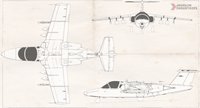
|
784 |
| ||
| B-67 Shahrukh | strategic bomber | 
|
3 |
| ||
| F-9 Ashavan II | Multi-role strike aircraft | 
|
120 |
| ||
| F-9 Ashavan III | Multi-role strike aircraft | 
|
282 | |||
| F-17 Axarana | air superiority fighter | 
|
42 | |||
| F-18 Cyclone | Strategic deep-strike fighter | 124 | ||||
| Javelin F-19 Greystrike | Air superiority fighter | 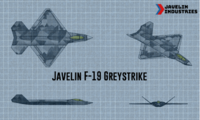
|
182 | |||
| F-21 Heavenscream | STOVL strike fighter | 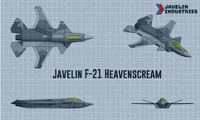
|
124 | |||
| Helicopters & Rotorcraft | ||||||
| H-1 Menace | Reconnaissance & attack rotorcraft | 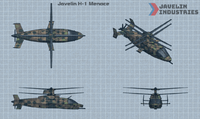
|
240 | In service from 1708 AN | ||
| H-2 Siren | Utility helicopter | 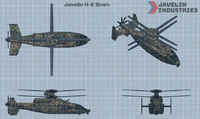
|
160 | |||
| R-2 Krähenwürger | Attack rotorcraft | 
|
292 | In service from 1708 AN. | ||
| Patrol Aircraft | ||||||
| AEW-1 Buscadora | Airborne early warning aircraft | 
|
10 | In service, 1708 AN. | ||
| P-2 Navegador | Maritime patrol aircraft | 
|
48 | In service, 1708 AN. | ||
| Trainer Aircraft | ||||||
| T-4/A-4 Flecha | Turboprop trainer | 
|
1,357 |
| ||
| T-5 Tejón de Miel | Jet trainer | 
|
400 |
| ||
| T-6 Preceptora | Twin-engine turboprop trainer | 
|
240 | In service, 1708 AN | ||
| T-7/A-6 Víbora | Turboprop trainer | 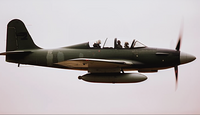 |
183 / 603 |
| ||
| Transport | ||||||
| C-11 Mula | transport | 
|
1,883 |
| ||
| C-12 Sojourner | Air-to-air refuelling aircraft and transport | 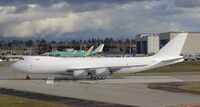
|
44 / 86 | |||
| MCJ100 | Talenore | transport/reconnaissance | 1 | Purchased from Talenore, 1681 AN. | ||
| Unmanned Aerial Vehicles | ||||||
| Javelin M-1 Eternal | High altitude theatre reconnaissance | 
|
6 |
| ||
| M-2 Dragoon | Remote reconnaissance & light attack | 
|
120 | |||
| Retired Aircraft | ||||||
| F-8 Shrike | Shireroth | fighter | 
|
12 | ||
| FA-9A Banshee | Talenore | fighter (single-seat Multirole) | 
|
23 | ||
| FA-9B Banshee | Talenore | fighter (Two-seat trainer/Multirole) | 3 | |||
| T-2/A-2 Saeqeh | light attack aircraft / trainer | 
|
10 | In service from 1659 AN onwards. Stationed in Wechua. Retired 1708 AN. | ||
| T-3 Akóntio | light attack aircraft / trainer | 
|
25 | In service from 1659 AN onwards. Stationed in Wechua. Retired 1708 AN. | ||
| TP-5 Alpha | Shireroth | jet trainer | 26 | Purchased from Talenore, 1681 AN. Retired 1708 AN. | ||
| UH-123 Hawk | Talenore | utility | 10 | Purchased from Talenore, 1681 AN. | ||
| UH-500 Protector | Talenore | light attack / scout | 4 | Purchased from Talenore, 1681 AN. | ||
Artillery
| Name | Origin | Type | № in Service | Image | Notes |
|---|---|---|---|---|---|
| Ground-based Air Defence System | |||||
| Athena Air Defense System | Short range air defence system | 0 / 600 launchers | 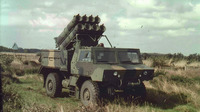 |
| |
| Geneva 2 | Anti-Ballistic Missile System | 184 batteries | 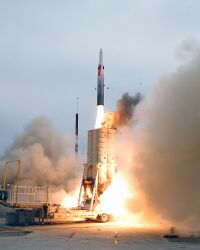 |
Initial entry into service 1680 AN. Full operational capacity 1703 AN onward. | |
| Silver Hammer |
|
C-RAM and short range air defence system | 824 batteries | 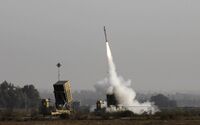 |
Initial entry into service 1675 AN. Full operational capacity 1688 AN onward. |
| System-2 Missile Complex | SAM system / rocket artillery | 96 batteries | Initial entry into service 1678 AN. Full operational capacity 1689 AN onward. | ||
| Self-propelled Artillery | |||||
| BK-IV 155 mm self-propelled howitzer | 155 mm self-propelled howitzer / field gun |
|
 |
Evaluation piece received 1690 AN. Final delivery received 1703 AN. | |
| Towed Artillery | |||||
| M1681 105 mm howitzer | 105 mm howitzer / field gun | 12,200 |  |
Entered service 1685 AN onwards. | |
Small Arms
| Name | Origin | Type | № in Service | Photo | Notes | |
|---|---|---|---|---|---|---|
| Knives, Grenades, Miscellaneous Implements | ||||||
| Ayllos (hunting-bolas) | 774,123 | Issued to the Federal Guards Service | ||||
| Chambi (cudgel) | 4,010,097 | Issued to the Federal Guards Service | ||||
| Chaska Chiqui (star-headed mace) | 467,859 | Issued to the Federal Guards Service | ||||
| Clinger Bomb, Adhesive Anti-Tank Grenade | 4,515,000 | |||||
| Cuncha Chucuna (axe) | 121,695 | Issued to the Federal Guards Service | ||||
| Estólica (spear-thrower) | 429,933 | Issued to the Federal Guards Service | ||||
| Florian Cocktail (Tar, sulphur, petrol, sand, & wick) | 60,000,000+ | |||||
| Huaraca (sling) | 910,455 | Issued to the Federal Guards Service | ||||
| Suchuc Chiqui (halberd) | 139,482 | Issued to the Federal Guards Service (ceremonial usage) | ||||
| Pistols / Carbines / Rifles | ||||||
| M1525 9 mm Pistol | Pistol | 565,000 |  |
Supplied by ESB Susa in 1673 & 1674. Widespread unlicensed production in Wechua regions. | ||
| M1581 7.62 mm Machine Carbine | Carbine | 1,803,000 |  |
| ||
| M1591 7.62 mm Rifle | Marksman Rifle | 1,150,000 | ||||
| M1656 9 mm SMG | Submachine Gun | 3,468,356 |  |
| ||
| M1686 assault rifle (7.62×67mmB) | Assault Rifle | 602,920 |  |
| ||
| M1690 machine pistol (9x19mm) | Machine Pistol | 2,500,000 |  |
Production licenced from Mishalan Arsenal. 2,500,000x machine-pistols ordered (1692 AN). | ||
| M1721 battle rifle (7.62×67mmB) | Service rifle | 59,950 / 1,680,000 |  |
|||
| Machine Guns | ||||||
| Polybolos 12.7 mm HMG | Heavy Machine Gun | 32,000 |  |
Supplied by ESB Susa in 1673 & 1674. | ||
Vehicles
| Name | Origin | Type | № in Service | Image | Notes |
|---|---|---|---|---|---|
| Armoured Fighting Vehicles | |||||
| AFV3 Vindicator | Main battle tank | 248 |  |
| |
| AFV4 Bastiat | Armoured guided missile vehicle |
|
 |
| |
| AFV5 Victor | Main battle tank | 227 |  |
| |
| HK-IV M1707 Stalker | Tracked anti-tank vehicle | 50 | 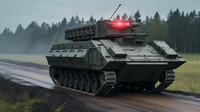 |
||
| Support Vehicles | |||||
| Ahvaz utility land cruiser | All-terrain utility vehicle | 670,547 | 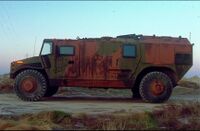 |
| |
| Rz.Kfz 1714 Razkampfwagen | Mine-Resistant Ambush Protected Vehicle | 12,000 |  |
Ordered in 1714 AN. | |
Vessels
| Name | Origin | Type | № in Service | Photo | Notes |
|---|---|---|---|---|---|
| Aircraft Carriers | |||||
| Proclamacion-class light aircraft carrier | Light aircraft carrier | 1 | 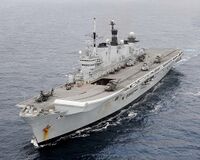
|
| |
| Amphibious Warfare Ships | |||||
| Behaurnais-class amphibious assault ship | Helicopter landing dock | 2 | 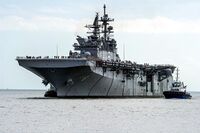 |
||
| Ignatius-class amphibious transport dock | Amphibious transport dock | 1 | 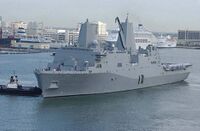 |
| |
| Cruisers | |||||
| Augustine-class cruiser | Guided missile cruiser | 6 |  |
| |
| Caputia-class helicopter cruiser | Helicopter-cruiser | 3 | 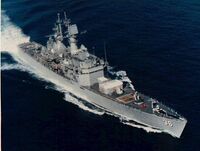 |
| |
| Dominator-class missile cruiser | Guided missile cruiser | 12 | 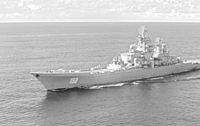 |
| |
| Manco Cápac-class cruiser | Light Cruiser (Auxiliary) | 60 |  |
| |
| Destroyers | |||||
| Valeria-class destroyer | Guided missile destroyer | 6 | 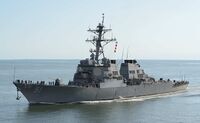 |
| |
| Custodia-class destroyer | Guided missile destroyer | 4 | 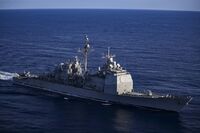
|
| |
| Patrol Vessels | |||||
| Alvarenga-class littoral combat ship | Littoral combat ship | 3 | 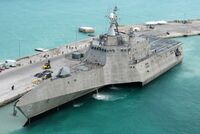 |
In service from 1687 AN. | |
| Isabella-class mine countermeasure ship | Minesweeper | 12 | 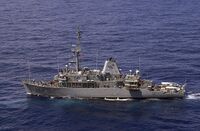 |
In service from 1685 AN. | |
| Klimatariá-class Missile Corvette | Corvette | 6 | Supplied by ESB Susa in 1673. | ||
| Melusine-class Missile Boat | Missile attack craft | 20 |  |
||
| Napoleon-class cutter | Maritime security cutter | 61 | 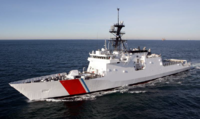 |
||
| Berthier-class Cutter | Medium maritime security cutter | 25 | 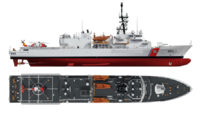
|
In service from 1687 AN.| Operated by naval crews for the Federal Coast Guard until the latter force assumed crewing duties in 1723 AN. | |
| Piriya-class coastal patrol ship | Patrol vessel | 30 | 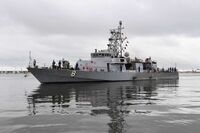 |
In service from 1686 AN. | |
| Seafox-class corvette | Corvette | 20 | 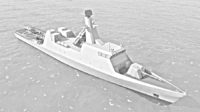 |
In service from 1685 AN. | |
| Submarines | |||||
| Type XXV U-Boat | Attack Submarine | 14 |  |
In service from 1679 AN. | |
| Type XXVII U-Boat | Attack Submarine | 15 | 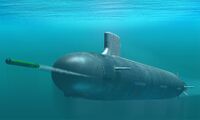 |
| |
| Type XXVIII U-Boat | Ballistic Missile Submarine | 5 | 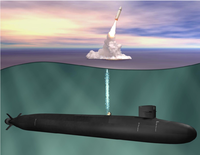 |
| |
| Auxiliaries | |||||
| Logistic Support Vessel | Logistic support ship | 5 |  |
| |
| Auxiliary Cruisers, no-standard type | Auxiliary cruiser | 28 |
| ||
| Cárdenas-class ocean surveillance ship | Ocean surveillance ship | 6 | 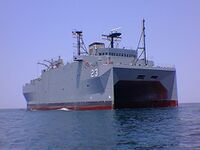 |
In service from 1687 AN. Assigned to the Colonial Fleet. | |
| Compassion-class hospital ship | Hospital ship | 10 | 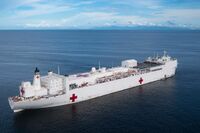 |
In service from 1687 AN. Assigned to the Colonial Fleet. | |
| Florimell-class Troop Landing Ship | Troop landing ship | 20 |
| ||
| Landing Ship, Tank, no-standard type | Landing ship | 6 | Local conversions made from 1676 AN onward. | ||
| Retired | |||||
| Rustolium-class Submarine | Submarine | 1 |  |
In service from 1679 AN to 1694 AN. Retired from service following discovery of extreme metal fatigue owing to age. Fate: Retired for conversion into a museum ship, assigned a permanent drydock berth in the port of San Francisco. | |
Ranks and uniforms
| Grade | Insignia | RP Rank Code | Rank | Pay |
|---|---|---|---|---|
| Chiefs of Staff (4.0) |
 |
OF-10 |
|
|
| General Officers (3.0) |
 |
OF-9 |
|
|
 |
OF-8 |
|
Combined Officer Pay x8 | |
 |
OF-7 |
|
Combined Officer Pay x7 | |
 |
OF-6 |
|
Combined Officer Pay x6 | |
| Senior Officers (2.1) |
 |
OF-5 |
|
Combined Officer Pay x5 |
 |
OF-4 |
|
Combined Officer Pay x4 | |
 |
OF-3 | Commandant | Combined Officer Pay x3 | |
| Junior Officers (2.2) |
 |
OF-2 | Captain | Combined Officer Pay x2 |
 |
OF-1 | Lieutenant |
| |
 |
OF(C) | Cadet |
| |
| Non-Commissioned Officers (1.1) |
File:FFNA Grade 1.1.png | OR-9 | Adjutant | Basic rate of pay x9 |
| OR-8 | Warrant Officer | Basic rate of pay x8 | ||
| OR-7 | Petty Officer | Basic rate of pay x7 | ||
| OR-6 | Banner Sergeant | Basic rate of pay x6 | ||
| OR-5 | Sergeant | Basic rate of pay x5 | ||
| Enlisted Men (1.2) |
File:FFNA Grade 1.2.png | OR-4 | Cabo | Basic rate of pay x4 |
| OR-3 |
|
Basic rate of pay x3 | ||
| OR-2 |
|
Basic rate of pay x2 | ||
| OR-1 |
|
|

